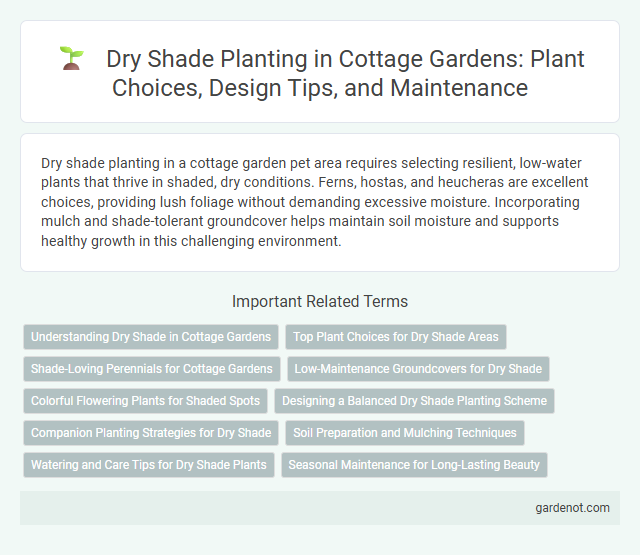Dry shade planting in a cottage garden pet area requires selecting resilient, low-water plants that thrive in shaded, dry conditions. Ferns, hostas, and heucheras are excellent choices, providing lush foliage without demanding excessive moisture. Incorporating mulch and shade-tolerant groundcover helps maintain soil moisture and supports healthy growth in this challenging environment.
Understanding Dry Shade in Cottage Gardens
Dry shade in cottage gardens refers to areas where sunlight is limited and soil moisture is low, often beneath dense tree canopies or along north-facing walls. Understanding these conditions is crucial for selecting plants such as hellebores, ferns, and lamium that thrive without excessive water and sunlight. Proper plant selection and soil management enhance the health and aesthetic appeal of a dry shade cottage garden.
Top Plant Choices for Dry Shade Areas
Top plant choices for dry shade areas in a cottage garden include hellebores, which thrive in low-light, dry soil conditions, and hardy ferns like the autumn fern that provide lush foliage without requiring much moisture. Epimediums offer delicate flowers and drought tolerance, making them ideal for shaded borders with minimal water. Other excellent options are lamium and lungwort, both known for their shade tolerance and ability to flourish in dry, shaded environments.
Shade-Loving Perennials for Cottage Gardens
Shade-loving perennials such as hostas, ferns, and hellebores thrive in dry shade conditions commonly found in cottage gardens. These plants are adapted to low light and minimal moisture, providing lush foliage and delicate blooms that enhance the garden's natural charm. Incorporating drought-tolerant shade perennials ensures year-round interest and supports biodiversity in shady cottage garden areas.
Low-Maintenance Groundcovers for Dry Shade
Low-maintenance groundcovers for dry shade in cottage gardens include species like Lamium maculatum, Pachysandra terminalis, and Vinca minor, all known for their drought tolerance and dense foliage that suppresses weeds. These plants thrive under trees or in shaded corners with minimal water and upkeep, making them ideal for gardeners seeking hardy, evergreen coverage. Incorporating dry shade groundcovers improves soil moisture retention and reduces erosion while enhancing garden aesthetics with varied textures and seasonal blooms.
Colorful Flowering Plants for Shaded Spots
Colorful flowering plants such as hellebores, astilbes, and fuchsias thrive in dry shade conditions, adding vibrant hues to cottage gardens with limited sunlight. These shade-tolerant perennials provide consistent blooms from spring through fall, enhancing garden diversity and visual interest. Incorporating hostas and columbines alongside colorful varieties creates layered textures and rich color palettes in shaded, dry garden niches.
Designing a Balanced Dry Shade Planting Scheme
Selecting plants with varying textures and heights, such as ferns, hostas, and heucheras, creates visual interest in dry shade garden designs. Incorporating drought-tolerant ground covers like sweet woodruff and lamium helps maintain moisture balance while minimizing soil erosion. Combining evergreen shrubs with seasonal bloomers ensures year-round structure and color in a balanced dry shade planting scheme.
Companion Planting Strategies for Dry Shade
Companion planting strategies for dry shade areas in cottage gardens include selecting drought-tolerant species such as ferns, hostas, and heucheras that thrive together while minimizing water competition. Incorporating deep-rooted companions like lavender or sedum enhances soil aeration and moisture retention, promoting healthier plant growth under low light and moisture conditions. Grouping plants with similar water and light requirements improves microclimate stability, reduces plant stress, and supports sustainable garden ecosystems in shaded, dry locations.
Soil Preparation and Mulching Techniques
Effective soil preparation for dry shade planting in a cottage garden involves loosening compacted soil and enriching it with organic matter like compost or aged leaf mold to improve moisture retention and nutrient availability. Mulching techniques such as applying a 2-3 inch layer of shredded bark, pine needles, or leaf mulch help regulate soil temperature, reduce evaporation, and suppress weeds, creating optimal conditions for shade-loving perennials and groundcovers. Proper mulching combined with well-prepared soil ensures healthy root development and sustainable moisture levels in dry, shaded garden areas.
Watering and Care Tips for Dry Shade Plants
Dry shade plants thrive with minimal watering, typically requiring moisture only during prolonged drought periods. Use mulch to retain soil moisture and regulate temperature, reducing the need for frequent watering. Regularly check soil moisture levels to prevent overwatering, which can lead to root rot in shade-tolerant species.
Seasonal Maintenance for Long-Lasting Beauty
Dry shade planting thrives with seasonal maintenance that includes regular mulching to retain soil moisture and suppress weeds, especially during dry summer months. Pruning dead or overgrown branches in early spring enhances airflow and light penetration, promoting healthy growth. Applying a balanced, slow-release fertilizer in late fall supports root development and prepares plants for the next growing season, ensuring sustained cottage garden beauty.
Dry shade planting Infographic

 gardenot.com
gardenot.com